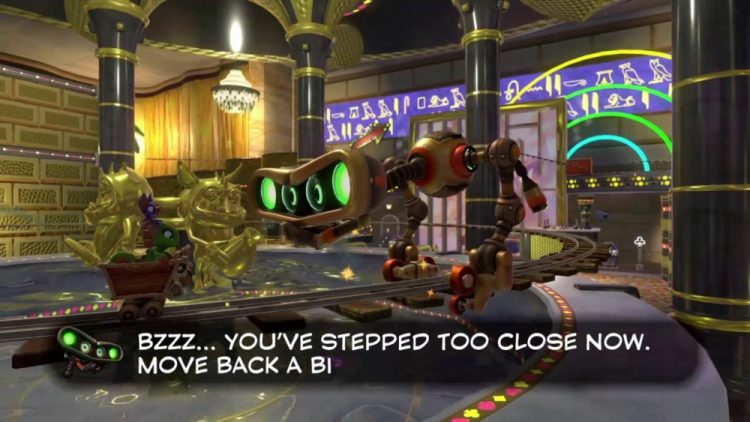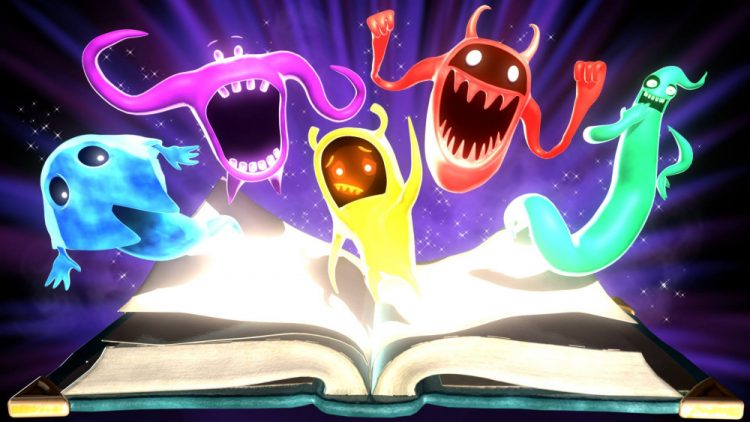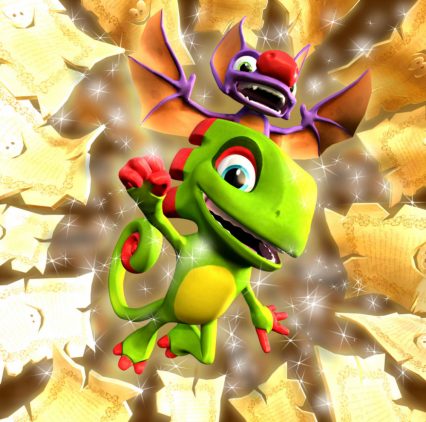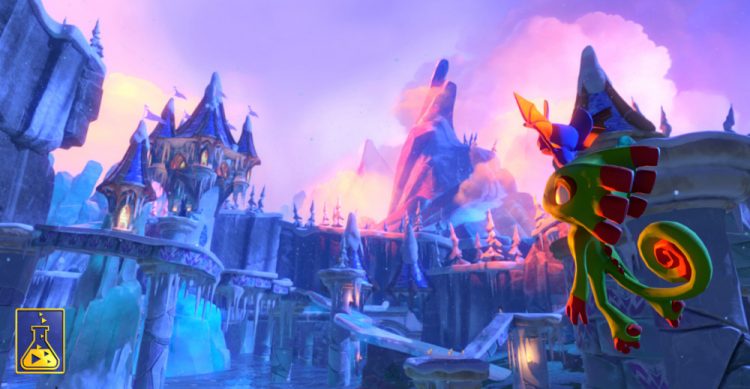Reviving the 3D Platformer
It was almost two years ago that I first heard of Playtonic Games’ Yooka-Laylee on Kickstarter, a self-titled “Rare-vival” promising to bring together the creative talents behind beloved retro titles like Donkey Kong Country and Conker’s Bad Fur Day to bring back the colorful worlds, cheeky humor, collectibles, and dynamic duo gameplay that made their other games so special. If you’re like me and have been waiting for a Banjo-Kazooie sequel, this is the closest you’re going to get to it.
Game Name: Yooka-Laylee
Platform(s): Xbox One, PlayStation 4, Steam (Windows, Linux, MacOS), Nintendo Switch
Publisher(s): Team17
Developer(s): Playtonic Games
Release Date: April 11, 2017
Price: $39.99 base, $49.99 Steam deluxe edition
Yooka-Laylee is the first game developed by Playtonic Games, though certainly not the first rodeo for most of the ex-Rare developers, several of whom have been around since the Donkey Kong Country days.
Players take control of a sensible, good-guy chameleon named Yooka and sassy, batty Laylee in a journey to collect the living “Pagies” of a mystical book they were using for a drink coaster. They have to collect them and defeat the greedy corporate tycoon Capital B and Dr. Quack before they take over the universe.
Our plucky heroes dive into magical storybooks containing jungle ruins, snow-capped mountains, and underwater landscapes on a bouncy, kooky collect-em-up of shiny trinkets, 3D platforming, and retro-ized mini gaming.
It’s a huge game, very eager to impress all levels of video game players. The majority of time is spent on exploration, but it’s apparent early on that there are many side quests that the player can choose to earn more Pagies and expand their worlds. There are puzzles, evil quizzes, shooting galleries, races, boss battles, dungeon dives, even a Donkey Kong-style mine cart challenge.
Along the way, Yooka and Laylee meet a fun cast of characters, trading silly puns and cheeky humor. There’s the smug, serpent salesman Trowzer and the adorable octo-scientist Dr. Puzz, who will give the duo new moves and transformations to help them in their adventure.
The open world format is refreshing, allowing the player to wander through the adventure at their own pace and choose specific “Tonics” to customize their play experience.

Gameplay
When asked about how he and his team were modernizing the 3D platformer, Playtonic studio director Gavin Price said in a recent interview with Ars Technica, “We looked across what had been going on in games and their much greater focus on not having linear paths that have to be followed at all times.”
This open world format rewards exploration in Yooka-Laylee’s five core worlds, which inspired my inner child’s curiosity. I’m the type of person who will run into every bush and break every box – and I was usually rewarded for it.
Platforming is central to Yooka-Laylee‘s exploration, and reaching new areas can be quite difficult at times. Acquiring specific Pagies required pinpoint precision and perfect timing, which occurs at least 1-2 times per level.
Yet in some instances, the game is more forgiving to the player than in older games. For instance, health-regenerating butterflies will appear next to the first world boss, and will continue to do so even if you mess up. You even have the option of walking away from most encounters without getting locked in.

From the first moment of picking up the controller, I found it fun to zip around the world with Yooka and Laylee – their movement speed is faster than it ever was (without cheating) in a Banjo-Kazooie game. The two lead characters are inseparable, playing as a tandem.
I find it hilarious that Laylee is a tiny bat, weighs only a few pounds, yet can lift Yooka over cliffs and chasms. There was almost no penalty for falling off walls, which decreases most of the frustration that comes from falling off platform challenges.
Yooka and Laylee use moves like tail whipping, butt-slamming, and sticking out their tongue. They’re quick and fun, especially when you’re just brushing off waves of little bad guys. The further you play, you acquire other fun, unexpected moves like tongue-grappling, fire-breathing, and tactical sonar blasting.
What’s a little unexpected is that for all the moves I was acquiring, some of the boss battles were not as interesting as I had hoped they would be. Most fell into this pattern of “hit 3 times, dodge, hit 3 times, dodge…” that was a little predictable. While it may be suitable for young players, I felt that I had out-grown that kind of boss fight.

A couple thing I find annoying in Yooka-Laylee are the lack of basic things that modern games have nowadays – an area map for navigating wide areas, providing hints for what to do next, and restarting certain quests if you exit the world.
The only time Playtonic holds the player’s hand is the beginning of the game, when Yooka comments on “giving myself a tutorial.” Back-tracking becomes very common, especially as the Checklist of Things to Do gets longer every time you meet a new NPC or receive a new quest.
Like its predecessors, Yooka-Laylee employs a “collect-a-thon” mechanic as a means of progression through the main narrative.
Pagies and Quills are the primary collectibles in the game, used to purchase anything from new abilities to accessing a new world. Ghostwriters are a living collectible, which is a fun, ongoing side quest like the way Jinjos were in Banjo-Kazooie. Eventually you can spend Pagies to invest in an existing world to unlock even more content. These expansions sometimes add verticality to the world, while others may create a self-contained area inside the storybook.
However, the novelty of collecting Pagies can wear out over time. I felt like at times I was completing quests just like they were errands, not individual adventures. Even the privilege of fighting the final boss requires 100 Pagies, which is a somewhat unpleasant surprise.
If you’re a fan of item collecting (or a die-hard game completionist, such as myself), you may have your work cut out for you.
The work it takes to collect all the Pagies and Quills can be frustrating for players who may be new to the 3D platforming genre. Some collectibles are out in the open, but most require solving puzzles, winning races, tricky platforming, or running a fetch errand. Some are straightforward, others are downright frustrating.

Graphics & Sound
The game features gorgeous, sprawling environments and designs created by renowned environment art director Steven Hurst, along with other Rare veterans Damien Sparks and David Rose. It’s like opening up a virtual coloring book, but brighter, sharper, and more vivid than every crayon in the box.
There are beautiful little touches with lighting, like the spotlight that appears above characters’ heads when you’re talking to them, Rextro’s blocky N64 skin, the glow around angry googly eyes. These kinds of things are never necessary, but they make the characters stand out from their surroundings. The landscapes, however, are truly brought to life by the game’s sound effects and musical scores.

Returning Rare cast members Grant Kirkhope, David Wise, and Steve Burke lent their creative talents to Yooka-Laylee’s soundtrack and voice talent. Like previous Rare games, there’s no human voice acting in Yooka-Laylee. Instead, you will hear all manner of grunts, squawks, burps, and hisses.
It may take some getting used to, but all the dialogue is explained through subtitles. I always loved the gibberish and cheeky humor in Banjo-Kazooie, always riding that fine line between cuddly and dirty at the same time. There was plenty of that humor among Yooka-Laylee‘s cast of characters, sound effects, and even among its set pieces.

The real standout about Yooka-Laylee’s sound are the world musical scores. Each world feels alive and full of personality. The marimba is featured heavily in Yooka-Laylee‘s main themes and creates a consistently tropical, bouncy kind of rhythm that matches the game’s light-heartedness and emulates Banjo-Kazooie’s soundtrack.
Each world in the game has its own unique orchestration and inner rhythm. Tribalstack Tropics is fast, walking tribal drum beat with rhythms on the upbeat. It’s very evocative of its namesake and creates an ideal backdrop for characters like the hapless explorer Clara, who’s found tied up inside of a bubbling green pot.
Glittergaze Glacier is one of my favorite tracks to listen to – the harmonic pizzacato strings create the feeling of snowflakes falling on a mystical landscape. The entire soundtrack is wonderful to listen to, and certain to invoke a heavy waves of nostalgia for Rare fans.
And, as promised by their Kickstarter stretch goals, composer Grant Kirkhope created a rap especially for Yooka-Laylee.
There are games with big budgets and more graphic “realism” in the market, but few of them feel as joyful and alive as Yooka-Laylee. Playtonic developers also added a fun touch, an optional “N64 shader” mode that imitates the graphical appearance of Nintendo 64 games.
Conclusion
Overall, the game is familiar and fun for a Banjo-Kazooie fan like me, but at times feels there is a lack of a guidance for the player and its collect-a-thon progression is frustrating grind.
While the characters are fun, quirky, and speak in a charming gibberish-sarcasm dialogue, I didn’t find them nearly as endearing as some of the characters from Banjo-Kazooie.
Yooka and Laylee are cute mascots, but at times it felt like they were poor imitations of their predecessors. Banjo in particular had a compelling narrative to save his sister in the first Banjo–Kazooie game, then stopping Gruntilda from vaporizing the entire world in the sequel. It was serious story with comic relief provided by the sarcastic Kazooie, who was a reluctant sidekick but lured by shinies and fighting baddies.

For Yooka and Laylee, they really went on an adventure because they felt like it – breaking into private property, trespassing in storybook worlds, and beating up people on the way.
I couldn’t even take the main villain Capital B seriously – he looks like a Minion-ized Gru from Despicable Me. His reason for being the bad guy isn’t nearly as funny or compelling as Gruntilda the Witch, whose sole reason for fighting Banjo and Kazooie is because she isn’t “the fairest of them all.”
For me, the story has a huge impact on the game’s replay value, just as important as mechanics and aesthetics.
In a recent interview with Ars Technica, studio director Gavin Price remarked, “I think players expect us to be the best of indie as well as the best of AAA. They expect a game created with the spirit of independence along with really high production values.”
“Certain assets have been redone, and features that we’d been going back and forth on have had to go in no what matter what once we’d raised so much money. We had set a bunch of stretch goals that we thought, at best, might be hit at the very end of the campaign, but they were all reached within a few hours!”
Even with all the hype around Yooka-Laylee, Playtonic didn’t take very many risks. They were in constant feedback with their fans and thanked them publicly for their support.
In the end, Playtonic produced a game that backers demanded while at the same time trying to avoid the pitfalls of past Kickstarter-funded games (Mighty No. 9 comes to mind having both technical and PR troubles). In a sense, Yooka–Laylee is the best that a 3D platformer has to offer, but also bring back some of its more tedious qualities.
With this in mind, the actual long-term benefits of Yooka-Laylee may be renewing interest among game developers and players who are willing to try 3D platformers again.
Other companies, such as Nintento’s announcement of Super Mario Odyssey, Sony’s remastered Crash Bandicoot ‘N-Sane’ collection, and Insomniac’s rebooted Ratchet & Clank, seem to be catching onto this revival.

Summary
Value & Rating
With bright colorful palette, cartoony soundtrack, and goofy cast of characters, Yooka-Laylee is sure to be a hit with younger players, as well as an older crowd eager to relive gaming’s past glories in 3D platforming and adventuring in an open world format.
It’s a visually beautiful game with a brilliant soundtrack, bringing together Rare’s technical and creative talents to the table for Playtonic Games’ debut. It was a fully des vu experience, reliving waves of warm nostalgia as it was happening in front of me.
However, I would hesitate to recommend this game to be worth buying at full retail value. It’s not particularly easy game to play if you’re hesitant about collect-a-thons, intense platforming, or the fact that you won’t have a map for the entire game.
For all its shortcomings, I personally enjoyed it and I look forward to seeing what else Playtonic Games has to offer in the future.
-
Overall Rating



